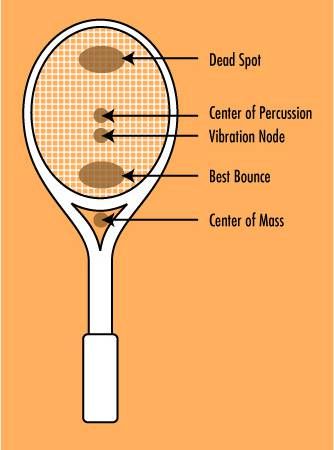So does anyone disagree with chicagojacks (even if it is recycled) information or conclusions? And if so can they provide research which would contradict it?
Hi marosmith,
 1.
1. Cool man, I invite you to hang onto that healthy skepticism. On any any given day, the volume of baseless assumptions, contradicting player experience, and questionable sources is pretty high around this ranch.
2. Having said that, what you are calling "recycled information", I would simply describe as "widely available published research" I'm just trying to explain the basics here, which ought to be no big whups. As it turns out, the truth is often stranger than fiction, not very intuitive at times, not widely known, and is often not accepted and derided by even the most avid racquet junkies.
3. It has been also been implied (by someone else a few posts ago) I'm procuring information from a single book. That's not the case. That's actually kind of funny, as I often take a fair amount of heat for providing
too many sources and links, which I'm happy to provide here. Lots of good reading in there, feel free to fact check and cross reference. It's all good.
The Really, Really, Short Version, Basics Of Racquet Power, ACOR:
(More Detail, Screen Grab Photos On My Posts #12, 13, 24, 34)
1. Ball velocity is the only measurable indicator of racquet power. On the court, ball velocity is typically measured with a radar gun and expressed as MPH or KPH. In laboratory conditions we might also measure film frames or measure bounce heights. However, recreational players don't often play with radar guns court side, so we often are using visual cues such as depth, trajectory, and height over the net to make guesses about ball speed. The problem is that all of these visual cues are highly sensitive to changes in string pattern, string tension, string type, and technique. Here are a just few examples: An open pattern and or slippery strings creates a higher arc, than a denser patterns or sticky strings, given the same stroke. If the player does not adjust to the additional height over the net, the ball might land deeper in the court, not because the ball is traveling faster, but because it is simply launching at a higher angle. However, if the player adjusts to the high arc by closing the racquet face, the result will be more spin. If the player now sees the ball diving into the court with more spin, and several feet to spare, this might create yet another stroke adjustment, wherein the player begins to open up his technique, will swing faster and with more confidence. The result of that 2nd adjustment would be even more spin and more ball speed.
2. All things being equal : A higher swingweight frame has more power. This assumes the swingspeed does not drop, which is easier said than done.
[1][2][3][5][6]
3. Racquet power is almost directly related to swingweight. It is the single most predictable indicator of racquet power when attempting to distinguish inherent power levels between different types of racquets.
[2][5][6]
4. In general : a stiffer frame is slightly more powerful than a flexible one. However, a flexible frame is just as powerful as a stiff frame when you hit the center of the strings. Stiffer frames have slightly more power when the ball is struck hit near the tip of the racquet.
[1][2][5][6]
5. All things being equal : A racquet with a bigger head has more power. If the string tension remains constant, the longer strings creates a softer string bed overall. A softer string bed creates a more powerful racquet. There are limits to this however, as you cannot play tennis with a butterfly net.
[1][6]
6. All things being equal: A racquet with a wider head will have more twistweight. This creates more power on balls that miss the sweet spot near the sides of the frame.
[5][6] For additional insight on wide heads and spin, see link
[4]
7. If you add length to an existing frame, swingweight increases dramatically. If two frames are equal SW, and one is longer, then the longer frame has less mass in the head, and the balance point is lower. So while the leverage is greater with the longer frame, it is harder to swing, and there will be less mass in the head per every SW unit.
[1][2][6]
Quote 3:
"Racquet stiffness has no effect on power when the ball is struck in the middle of the strings, but stiff racquets are more powerful when the ball is struck nearer the tip of the racquet"
-- Rod Cross, Chapter 14, Racquet Power, The Physics And Technology Of Tennis. Link
[6]
References, Links, Suggested Reading:
Link
[1] Basic Facts about Frames and Strings,
The United States Racquet Stringers Association
http://www.racquettech.com/top/basic_facts.html
http://www.tennis-warehouse.com/lc/basicfacts.html
Link
[2] Raw Racquet Power, By Rod Cross
http://www.racquetsportsindustry.com/articles/2006/02/raw_racquet_power.html
Link
[3] Racquet Handle Weighting And Maneuverablility, by Rod Cross
http://www.racquetsportsindustry.com/articles/2006/04/racquet_handle_weighting_and_m.html
Link
[4] The Inch That Changed Tennis Forever, By Rod Cross
http://www.racquetsportsindustry.com/articles/2006/01/the_inch_that_changed_tennis_f.html
Link
[5] Racquet Power Comparison Tool
http://twu.tennis-warehouse.com/cgi-bin/comparepower.cgi
Link
[6] The Physics And Technology Of Tennis
http://www.tennis-warehouse.com/The_Physics_and_Technology_of_Tennis/descpage-PHYSICS.html
Link
[7] Mark Philippoussis Service Speed Testing:
Averages 124 MPH with a Wood Racquet, and 126 with his Graphite Racquet,
Time Magazine, June 2009
http://www.time.com/time/magazine/article/0,9171,1899876,00.html
Link
[8] Power Potential, The Total Performance Measurement
http://twu.tennis-warehouse.com/learning_center/totalperformance.php
Link
[9] The Ingredients Of Maximum Shot Speed
http://twu.tennis-warehouse.com/learning_center/maxspeedeasy.php
Link
[10] Maximum Shot Speed, Where to Hit on the Racquet
http://twu.tennis-warehouse.com/learning_center/maxshotspeed.php
Link
[11] Why Is Maximum Power In the Throat and Maximum Shot Speed Toward The Tip?
http://twu.tennis-warehouse.com/learning_center/PPandspeed.php
Link
[12] Compare Racquet Shot Speeds (Mph)
http://twu.tennis-warehouse.com/cgi-bin/comparespeed.cgi
Link
[13] Compare Racquet Trajectories
http://twu.tennis-warehouse.com/cgi-bin/trajectory_compare.cgi
Link
[14] More Tennis Physics, Rod Cross
http://www.physics.usyd.edu.au/~cross/presentations.html
Link
[15] Power, Does the Racquet Matter?
http://twu.tennis-warehouse.com/learning_center/racquetcontribution.php
Link
[16] Power Potential Test Procedure
http://twu.tennis-warehouse.com/learning_center/test_method.php
PS - Corners, thanks for chiming in.. I was hoping you might swing by and contribute.
- Jack



